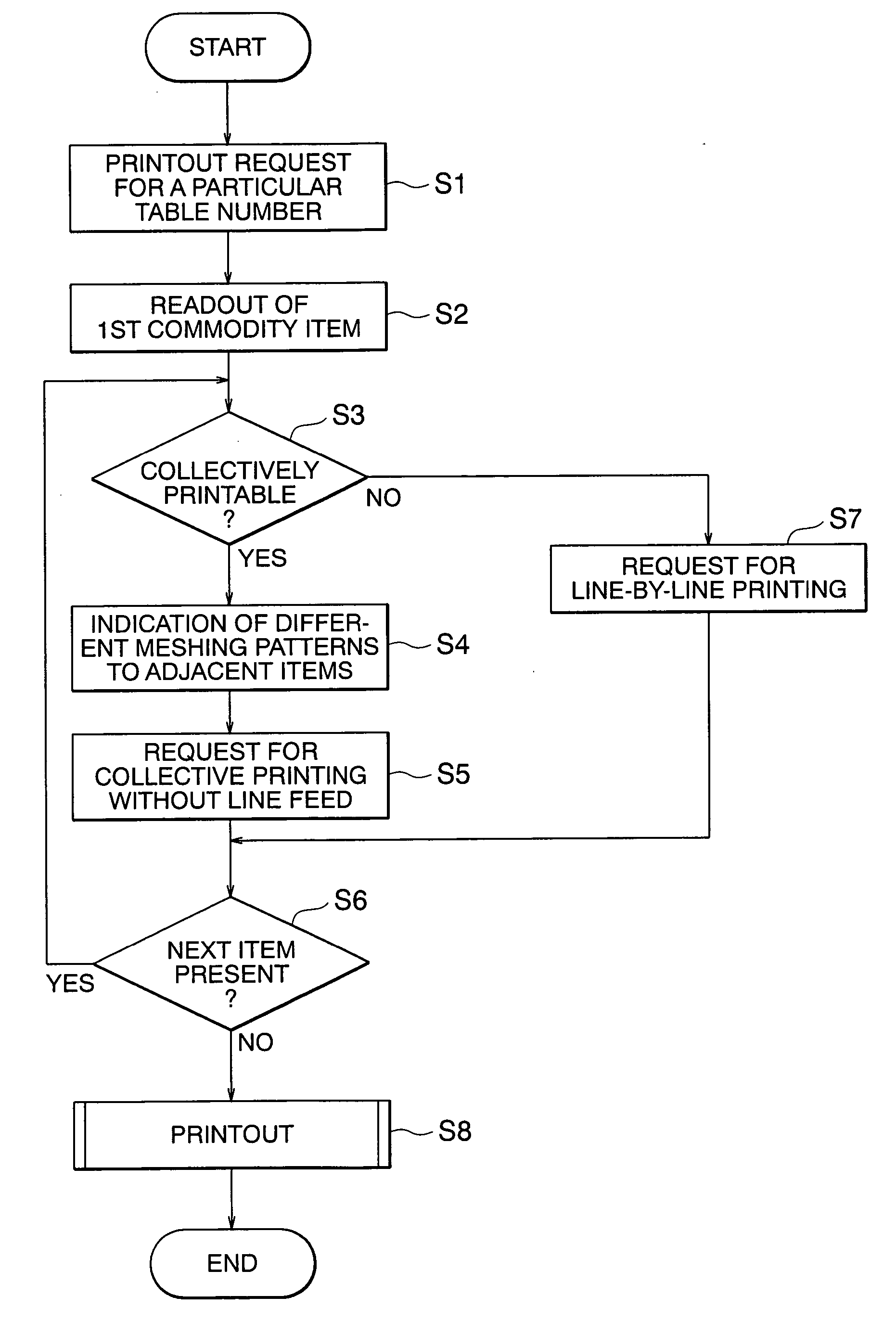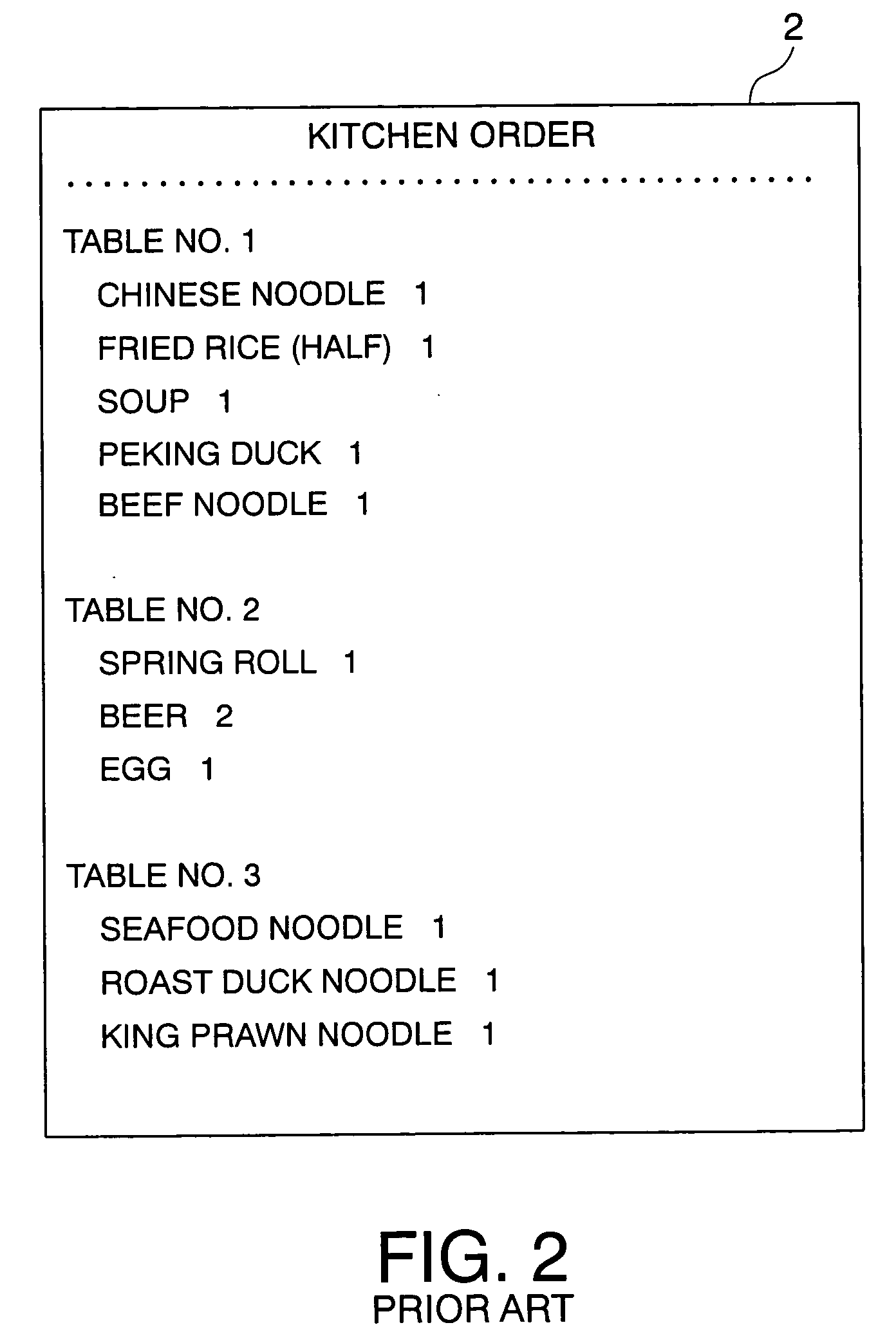Data printing method using a small printer and a commodity data register
a data and register technology, applied in the field of data printing methods, can solve the problems of easy occurrence of errors, large number of lines printed on receipts, troublesome operation of recording purchased items in an account book, etc., and achieve the effect of reducing the number of printed lines and the length of the print sheet, saving printing costs, and further reducing printing costs
- Summary
- Abstract
- Description
- Claims
- Application Information
AI Technical Summary
Benefits of technology
Problems solved by technology
Method used
Image
Examples
first embodiment
[0041] First Embodiment
[0042] Referring to FIG. 3, a first embodiment of this invention will be described.
[0043] Referring to FIG. 3, a receipt 3 is prepared in a restaurant upon payment. The receipt 3 is prepared from a customer's order already entered and shows a table number as a customer number.
[0044] The order received by a waiter is recorded as commodity data including a commodity name and a quantity of each commodity item in correspondence to the table number. In FIG. 3, commodity names of a plurality of commodity items grouped into a commodity set such as a set meal and having no unit prices are printed continuously in a single paragraph without line feed by the use of different meshing patterns so as to facilitate distinguishment between adjacent ones of the commodity items from each other. In FIG. 3, lines of a subtotal, a total, and a change are printed with meshing patterns so as to easily confirm the detail of the payment and to reduce the number of printed lines.
[00...
second embodiment
[0046] Second Embodiment
[0047] Referring to FIGS. 4 and 5, a second embodiment of this invention will be described.
[0048]FIG. 4 shows a kitchen sheet (kitchen order sheet) 4 prepared in a restaurant upon requesting cooking to a kitchen. The kitchen sheet 4 is prepared from a customer's order already entered and shows a table number as a customer number.
[0049] The order received by a waiter is recorded as commodity data including a commodity name and a quantity of each commodity item in correspondence to the table number. In FIG. 4, the commodity names and the quantities of the commodity items per table, similar to those in FIG. 2, are continuously and collectively printed without line feed with meshing patterns different from one another so as to facilitate distinguishment between adjacent ones.
[0050] Referring to FIG. 5, types of meshing patterns may be changed line by line in case of collective printing over two or more lines. In FIG. 5, four types of meshing patterns A, B, C, ...
third embodiment
[0053] Third Embodiment
[0054] Referring to FIG. 6, a third embodiment of this invention will be described. The third embodiment is a procedure for realizing the first or the second embodiment.
[0055] Referring to FIG. 6, description will be made of an operation of printing the receipt 3 in the first embodiment and the kitchen sheet 4 in the second embodiment on the print sheet. In the restaurant, the customer number is given by the table number. In order to prepare the kitchen sheet or the receipt showing the content of the customer's order already entered when food preparation is requested or when payment is requested, the waiter enters a printout request for the content of the customer's order on a commodity data register (hereinafter simply called a register) in the following manner.
[0056] The order received by the waiter is recorded as the commodity data including the commodity name and the quantity of each commodity item in correspondence to the table number. For example, the ...
PUM
 Login to View More
Login to View More Abstract
Description
Claims
Application Information
 Login to View More
Login to View More - R&D
- Intellectual Property
- Life Sciences
- Materials
- Tech Scout
- Unparalleled Data Quality
- Higher Quality Content
- 60% Fewer Hallucinations
Browse by: Latest US Patents, China's latest patents, Technical Efficacy Thesaurus, Application Domain, Technology Topic, Popular Technical Reports.
© 2025 PatSnap. All rights reserved.Legal|Privacy policy|Modern Slavery Act Transparency Statement|Sitemap|About US| Contact US: help@patsnap.com



